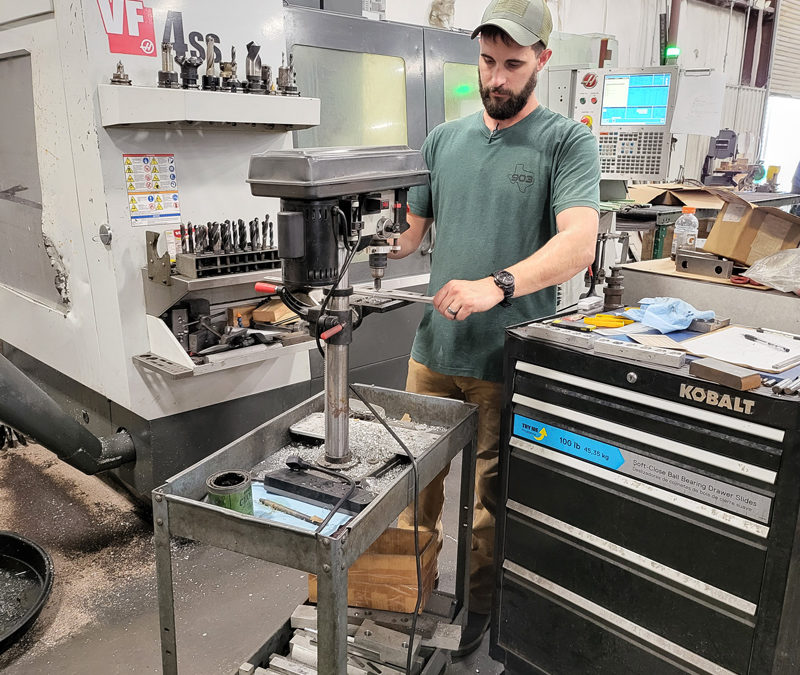Assembly for FDOT Bullet Rail
From Raw Extrusion to Ready-to-Use: The Critical Role of Fabrication & Assembly
Aluminum extrusions are versatile, lightweight, and durable—but they’re rarely ready for action straight off the press. To meet the demands of industries like construction, transportation, and marine engineering, extrusions often require precise fabrication and assembly. Whether creating FDOT Bullet Rail safety systems or dock ladders, post-press processes like aluminum extrusion punching and machining aluminum tubing ensure components perform flawlessly in their final applications. Here’s how it works.
Why Fabrication & Assembly Matter
Raw aluminum extrusions are like blank canvases. While their initial shape is determined by the extrusion press, secondary processes refine their functionality. For example:
- Aluminum extrusion punching adds holes or slots for bolts in Bullet Rail clamp systems.
- Machining aluminum extrusion ensures precise dimensions for parts like channel punching handrails.
- Cutting, welding, or bending transforms extrusions into dock ladders or structural supports.
Without these steps, extrusions lack the precision, strength, or compatibility needed for real-world use.
Key Fabrication Processes for Aluminum Extrusions
1. Precision Machining
Machining aluminum extrusion involves drilling, milling, or turning to achieve tight tolerances. For instance, machining aluminum tubing for marine applications ensures seamless integration with boat railings or dock hardware.
Example: A client needed corrosion-resistant dock ladders with non-slip steps. By machining extruded tubing to exact specifications, we created a durable, safety-compliant solution.
2. Punching and Notching
Aluminum extrusion punching creates openings for fasteners, wiring, or ventilation. This process is critical for components like FDOT Bullet Rail brackets or channel punching handrails, where alignment is key.
Example: A transportation project required Bullet Rail clamp systems with uniform bolt holes. Semi-automated punching ensured consistency across 500+ units.
3. Cutting and Welding
Extrusions are often cut to length or welded into complex shapes. Laser cutting guarantees clean edges, while TIG welding maintains structural integrity.
Example: A custom channel punching handrail design required angled welds to fit a curved staircase. Our team delivered a seamless, load-bearing solution.
4. Surface Treatment
Anodizing, powder coating, or plating enhances corrosion resistance and aesthetics. For FDOT Bullet Rail systems, powder coating adds a protective layer against harsh weather.
Assembly: Turning Parts into Functional Systems
Fabricated components become functional products through assembly. This stage might include:
- Attaching Bullet Rail clamps to posts using pre-punched holes.
- Bolting machined aluminum tubing sections into dock ladders.
- Integrating channel punching handrails with glass panels for commercial buildings.
Case Study: A contractor needed FDOT-compliant Bullet Rail for a highway project. We supplied pre-punched extrusions, machined connectors, and assembly instructions, reducing onsite labor by 40%.
Applications of Fabricated Aluminum Extrusions
- Transportation: FDOT Bullet Rail systems for highways.
- Marine & Industrial: Corrosion-resistant dock ladders and platforms.
- Architecture: Custom channel punching handrails for staircases.
- Utilities: Machined aluminum tubing for electrical enclosures.
Advantages of Professional Fabrication & Assembly
- Precision: Tight tolerances ensure parts fit perfectly.
- Durability: Proper machining and coating extend product life.
- Compliance: Meet standards like FDOT for safety-critical projects.
- Cost Efficiency: Reduce waste and onsite labor with pre-fabricated components.
Key Takeaways
- Fabrication processes like aluminum extrusion punching and machining are essential for functional components.
- Assembly transforms parts into systems like FDOT Bullet Rail or dock ladders.
- Professional fabrication ensures compliance, durability, and cost savings.
FAQ
Q: Can you customize aluminum extrusions for unique projects?
A: Absolutely. We specialize in machining aluminum tubing, punching, and welding to meet custom specs.
Q: Are your FDOT Bullet Rail systems compliant with state regulations?
A: Yes. Our rail systems meet all FDOT safety and durability standards.
Q: How long does aluminum extrusion punching take?
A: Turnaround depends on complexity, but semi-automated tools often complete jobs in 2–5 days.
Q: Do you provide assembly services for dock ladders?
A: Yes. We offer full fabrication, coating, and assembly to deliver ready-to-install products.
Q: What surface treatments do you recommend for marine environments?
A: Powder coating or anodizing provides optimal corrosion resistance for dock ladders and railings.
Conclusion
Aluminum extrusions are only as strong as their fabrication and assembly. By investing in precision machining aluminum extrusion, punching, and collaborative design, we turn raw materials into reliable solutions like FDOT Bullet Rail systems, dock ladders, and channel punching handrails. Whether your project demands compliance, customization, or cost efficiency, expert post-press processing ensures your components perform—and endure.



